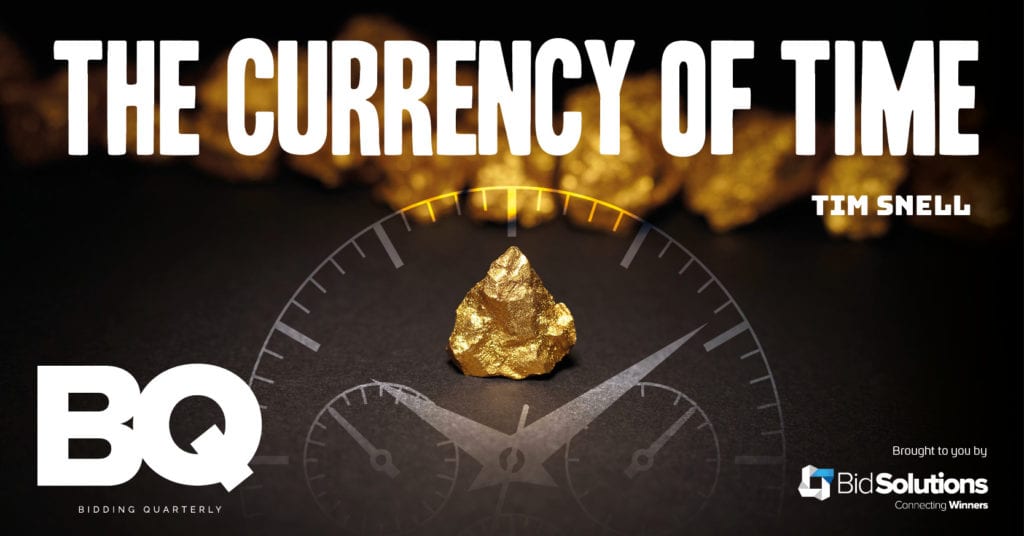
“All we have to decide is what to do with the time that is given us.”
J. R. R. Tolkien
If 2020 taught us one thing, it’s that time marches on – pandemic or not. Our task is not to languish in wishful thinking for more hours in the day; it’s to recognise that we all have the same 24 hours. We have to work out how to use those hours to create the impact we want in the world.
Bid professionals often find themselves running a linear race towards the deadline – a horizontal story (or the “horror story” to quote a good friend of mine) that begins with opportunity identification and ends at contract award. Like any good story, there are allies and obstacles, and unexpected twists and turns that guide us ever onwards. One thing remains the same – time stops for no one.
When we’re in the fray, wearing the badge of ‘busy’, it’s too easy to forget that time is the most valuable currency we all possess. How we spend it has a massive impact on our quality of life. So how do we shift our perception to the value of time and its importance as a currency – one we’re empowered to choose how we spend?
Parkinson’s Law[1] is the adage that “work expands so as to fill the time available for its completion”. Anyone working in bids has seen this play out project after project. The logic, therefore, is that anything with a deadline focuses the mind, and helps us to prioritise what’s ‘important’. In effect, by placing limitations on something, we become more creative about how we achieve what’s needed within those constraints.
If this is true, and we all crave more time to fit everything in, to make an impact, or to leave a legacy, then we must understand that our time is finite. If we can’t create more time, then we must recognise its value and begin to make choices about how we invest it.
I use Mark Silverman’s Only 10s[2] methodology (from: Only 10s: Using Distraction to Get the Right Things Done) to help me get the right things done, and to make my unconscious choices conscious. This way, when I’m investing my most valuable asset in something meaningless, I do so from a place of agency, knowing that I’m ‘choosing’ to spend my time this way and catching myself when I really want to be doing something else.
By understanding that time is my currency (it’s how I’m often paid, after all) and using the ideas from Only 10s, I’ve become more aware of what I put my attention on, who I spend my time with, and the activities that I choose to invest my time in. I’ve recommended Only 10s to clients who report a similar awareness and shift in their own lives. This has helped reset my internal compass, reprioritise my personal and professional goals and bring forward things that I have been putting off. (Sometimes these are joyful things that I wistfully say, “I’ll do it next year…”.)
So what’s a 10 for me? I’ve adopted the criteria that Mark suggests in his book:
- I really want to do this today
- It has a deadline or a consequence if it isn’t done
- It has been scheduled
That might seem simplistic but it’s the simplicity and the rationale Mark explains in his book that makes it so powerful.
At a day-to-day level, it has helped me (and my clients) to become much clearer on what’s in and what’s out of my daily ‘to do’ list.
“As a leader and a team member, this has meant getting really honest with myself and the people I collaborate with – determining what’s important, what needs doing right now, and what’s possible given the various constraints and demands we all face.”
More importantly, it has given me the courage to say “No”, when I’m so used to saying “Yes”; “Yes” to people please, to keep the plates spinning and to keep wearing that badge of ‘busy’ that I can use as an excuse for missing the things that are truly important.
In truth, the decision criteria have become even clearer – if it’s not a “Hell yes”, it has to be a “No”. That comes from a place of intellect and a place of feeling. With that kind of clarity, I have created more space for the things that light me up and ultimately lead me step-by-step toward my goals – the main one being to focus on what matters most.
“You have no time left to kill, so how you spend your time now is how your live this life.” Mark J Silverman
How are you spending yours?
[1] https://en.wikipedia.org/wiki/Parkinson%27s_law
[2] https://www.markjsilverman.com/books
This article was written by Tim Snell.
Tim is a freelance Capture Specialist/Trainer, Business Winning Consultant and Executive Coach. He has shaped his career helping companies create successful, high performance bid and proposal teams in the UK, the Middle East and Australia. He volunteers as the Deputy Chief Examiner for APMP, is a professionally trained and certified Coach, and holds APMP Professional Level certification.

